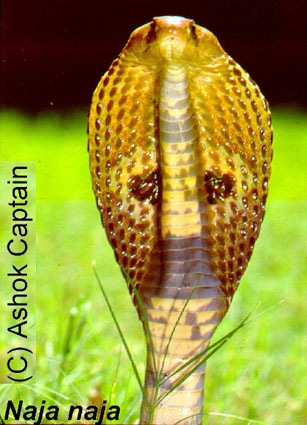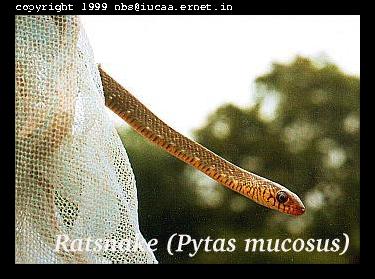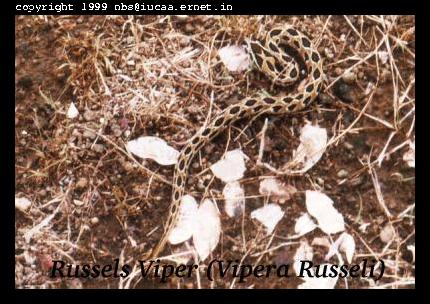There are only 6 species of snakes amongst the 270 species found in India that are both deadly and common. Of these, three species are found on the University of Pune campus. They are the Binocellate Cobra, the Common Krait and the Russell's Viper. This page lists a few simple ways of identifying these three species. I hope to add more pictures soon.

Binocellate Cobra (Naja naja)
This snake has a distinct U-shaped marking behind its head (the spectacle mark). The ribs just below the head are distinctly elongated compared to the rest of the body. The neck region is dilatable. When cornered, it invariably raises its hood to intimidate the attacker. This snake can grow to a maximum length of 1.8 m. This snake is often confused with the non-poisonous Ratsnake (Pytas mucosus) pictured below.

Common Krait (Bungarus caeruleus)
This snake has a row of enlarged hexagonal scales on its dorsal side running along the entire length of its body. This snake can grow to about 1.5 m in length. It has a number of paired white colored cross bars which disappear towards the anterior part of the body. It is usually active at night. The snake is usually steel-blue or black in color.

Russell's Viper (Vipera russelli)
This snake when full grown is unmistakable. It has a thick body like a python (often up to 150 m.m. thick) with dark brown diamond shaped markings that run in three rows. When threatened it coils up and hisses loudly and continuously. The head is triangular in shape. It grows to a maximum length of about 1.6 m. This snake is quite common on the IUCAA campus. This snake is usually brownish in color.
The notes given above are merely suggestive. Body color varies widely among snakes of the same species and should not be used as an aid to identification. Confirmed identification of snakes can only be done by counting scales on its body very carefully. The only really useful book for doing this is Smith (1943).
Every unidentified snake should be treated as carefully as if it is a poisonous snake. Do not handle any snake which you have not previously confirmed to be non-poisonous.
References
Smith M.A., The Fauna of British India, Ceylon and Burma, including the whole of the Indo Chinese sub-region. Reptilia and Amphibia Vol. 3, reprinted by Natraj Publishers, 1943, Rs. 250